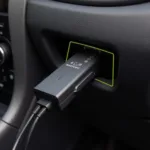The world of car diagnostics has gone digital, and “[mac obd2 scanner]” is a search term that’s becoming increasingly common. More and more car owners are turning to their Apple devices for help understanding their vehicles. This comprehensive guide will delve into everything you need to know about using a Mac OBD2 scanner, from choosing the right device to understanding those cryptic fault codes.
Why Choose a Mac for OBD2 Scanning?
While Windows-based solutions have traditionally dominated the OBD2 market, Macs offer a user-friendly interface and powerful software options that make them a great choice for car diagnostics.
Finding the Perfect Mac OBD2 Scanner
The first step is choosing the right OBD2 scanner that seamlessly pairs with your Mac. Here’s what to consider:
- Compatibility: Ensure the scanner explicitly states macOS compatibility, as not all scanners support both Windows and Mac.
- Connectivity: OBD2 scanners connect to your Mac either wirelessly through Bluetooth or using a USB cable. Bluetooth offers convenience, while a wired connection can be more stable.
- Software Features: Different scanners come bundled with varying software capabilities. Consider what features are important to you, such as live data streaming, fault code reading and clearing, and advanced diagnostics.
Popular Mac OBD2 Software Options
Once you have your scanner, you’ll need reliable software to interpret the data. Here are some highly-rated options:
- OBD Fusion: Known for its intuitive interface and extensive vehicle compatibility. It offers live data, graphing, fault code definitions, and even emissions readiness checks.
- OBD Auto Doctor: A budget-friendly option that provides the essentials, like reading and clearing fault codes and viewing live sensor data.
- DashCommand: Focuses on performance monitoring, allowing you to track metrics like acceleration, braking, and fuel economy.
Demystifying OBD2 Fault Codes
When your car’s “Check Engine” light illuminates, it’s storing a fault code in its computer. A Mac OBD2 scanner can read these codes, which are formatted as a combination of letters and numbers.
- Understanding the Structure: Codes follow a standardized format:
- The first letter indicates the system affected (e.g., “P” for Powertrain, “B” for Body, “C” for Chassis, “U” for Network).
- The second character signifies whether the code is generic (0) or manufacturer-specific (1 or more).
- The remaining digits pinpoint the specific fault within that system.
- Finding Code Definitions: Once you’ve retrieved the code, use your OBD2 software or an online database to look up its meaning. This will provide insights into the potential causes of the issue.
Going Beyond Basic Diagnostics
Many Mac OBD2 scanners and software offer advanced features for those who want to delve deeper:
- Live Data Streaming: Observe real-time sensor readings like engine RPM, coolant temperature, and oxygen sensor voltage. This data can help you identify subtle issues and monitor performance.
- Freeze Frame Data: Provides a snapshot of the engine’s parameters at the time a fault code was stored, offering valuable clues for diagnosis.
- Emissions Readiness Tests: Check if your vehicle’s emissions system is functioning correctly, which is essential for passing emissions tests.
Mac OBD2 Scanners: A Valuable Tool for All Car Owners
A [mac obd2 scanner] isn’t just for mechanics or car enthusiasts. It’s a valuable tool for any Mac user who wants to:
- Save Money: Diagnose car problems yourself before heading to a mechanic, potentially avoiding unnecessary repairs.
- Gain Peace of Mind: Regularly check your car’s health and catch minor issues before they escalate into costly repairs.
- Become More Car Savvy: Understand how your car works and make more informed decisions about its maintenance.
Conclusion
With the right Mac OBD2 scanner and software, you can unlock a wealth of information about your car’s health and performance. Embrace the power of technology and take control of your car maintenance journey.
FAQs about Mac OBD2 Scanners
Q: Can I use any OBD2 scanner with my Mac?
A: Not all OBD2 scanners are compatible with macOS. Look for scanners that explicitly state Mac compatibility.
Q: Do I need a WiFi connection to use a Mac OBD2 scanner?
A: You don’t need WiFi to connect the scanner to your Mac. However, you might need an internet connection to download software updates or access online code databases.
Q: Can a Mac OBD2 scanner reset the check engine light?
A: Yes, most Mac OBD2 scanners allow you to clear fault codes, which will turn off the check engine light if the issue has been resolved.
Q: What should I do if my Mac doesn’t recognize the OBD2 scanner?
A: Double-check the scanner’s compatibility with macOS, ensure it’s properly connected, and try restarting both your Mac and the scanner. If issues persist, refer to the manufacturer’s instructions or contact their support.
Q: Are Mac OBD2 scanners as good as Windows-based options?
A: Yes, Mac OBD2 scanners can be just as powerful and feature-rich as Windows-based options. The key is to choose a high-quality scanner and software that meets your needs.
If you have any further questions or need assistance with choosing the right [mac tool obd2 scanner], our team is ready to help. Contact us via WhatsApp: +1(641)206-8880 or Email: [email protected]. Our customer support is available 24/7 to assist you.
